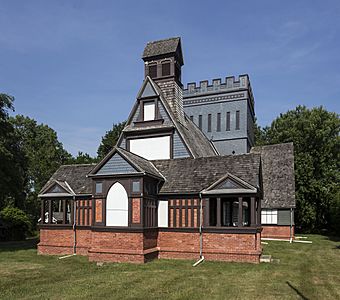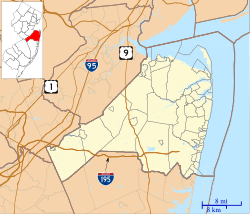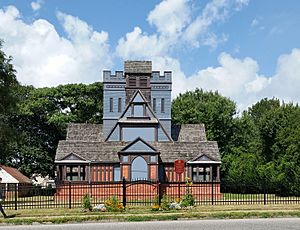Church of the Presidents (New Jersey) facts for kids
|
Church of the Presidents
|
|

View of the chapel in 2016 after substantial restoration work
|
|
| Location | 1260 Ocean Avenue, Long Branch, New Jersey |
|---|---|
| Area | 0.1 acres (0.040 ha) |
| Built | 1879 |
| Architect | William Appleton Potter and Robert Henderson Robertson |
| Architectural style | Carpenter Gothic |
| NRHP reference No. | 76001169 |
Quick facts for kids Significant dates |
|
| Added to NRHP | November 07, 1976 |
The Church of the Presidents is a special old church building in Long Branch, New Jersey. It's called this because seven United States presidents once worshipped there. These presidents were Ulysses S. Grant, Rutherford B. Hayes, James A. Garfield, Chester A. Arthur, Benjamin Harrison, William McKinley, and Woodrow Wilson. All of them, except Grant, were president when they visited.
For about 75 years, this church was a summer chapel. It's located right across the street from the Atlantic Ocean. In 1953, the church was officially closed and almost torn down. But people who cared about history stepped in. In 1955, it became the Long Branch Historical Museum. Today, the building is being fixed up and is not open to visitors.
Contents
History of the Church
The Church of the Presidents first opened in 1879. It was known as St. James Protestant Episcopal Chapel. It was a smaller branch of another church in Long Branch. It earned its famous nickname because so many presidents came to worship there.
Building Design and Style
The chapel was designed in a style called Carpenter Gothic. This means it looks like a traditional Gothic church but is made mostly of wood. The architects were William Appleton Potter and Robert Henderson Robertson. They were well-known for designing other important buildings.
Long Branch: A Presidential Vacation Spot
In the 1800s, Long Branch was a very popular vacation spot. Many wealthy families and important people, including presidents, came to spend their summers by the Jersey Shore. In 1861, Mary Todd Lincoln, President Lincoln's wife, visited Long Branch. This started a tradition of important people from Washington D.C. coming to the town.
During the late 1800s and early 1900s, Long Branch was one of the best summer places in the country. Rich families like the Goulds, Vanderbilts, and Drexels had huge summer homes nearby. A newspaper once reported that the people attending church on a Sunday in 1886 were worth a lot of money! Sometimes, the church collected as much as $8,000 in donations on a single Sunday.
Challenges and Preservation
By 1925, the church was having money problems. Local people helped save it with their donations. A man named Henry Levy, who was not a member of the church, even paid its overdue taxes. He said, "Although we are not of the same faith, we believe in the same God." This help was only temporary.
In 1949, church services stopped because there were fewer than 40 members left. The vicar, Rev. Christopher H. Snyder, tried to get Congress to make it a national shrine. In 1953, a non-profit group called the Long Branch Historical Museum Association bought the building. For 46 years, it was a local museum. However, after 120 years of ocean weather, the building started to fall apart.
The museum closed in 1999 because it needed many repairs. In 2003, private donations helped make the building stable. Special windows and historical items were carefully removed and stored. These items included a silk American flag that covered President Garfield's casket, President Grant's gun cabinet, and guest books signed by the presidents.
The church is now part of the National Trust for Historic Preservation's Save America's Treasures program. This means it's recognized as a very important historical site that needs help. It was added to the National Register of Historic Places on November 7, 1976.
Architectural Features
The Church of the Presidents has several interesting design elements.
- The chapel is made of wood and sits on a brick base. This is typical of the Carpenter Gothic style.
- Two beautiful stained glass windows were installed in the 1800s. They are believed to be made by the famous Louis Comfort Tiffany Studios.
- The roof is made from cedar shakes, which are thin pieces of wood.
- The building has decorative quatrefoils, which are shapes with four lobes, made of Spanish mahogany.
- An impressive tower was added to the church between 1879 and 1895.
- On the church property, there is also a small building called The Garfield Tea House. It was built from railroad ties. These ties were used in 1881 to create a special train track. This track was built to move the injured President Garfield from the train station to a nearby cottage, where he later passed away.
Renovation Efforts
The Church of the Presidents is the only building left that is connected to all seven presidents who vacationed in Long Branch. In 1999, the Long Branch Historical Museum Association started raising money to save the building.
Stabilizing the Structure
The first step was to make sure the building wouldn't collapse. The old wooden floor was removed. Strong concrete was poured to support the building. Steel supports replaced old wooden posts that had rotted. The stained-glass windows, original altar, organ, and handmade pews were all removed and stored safely during this work.
Exterior Repairs
After the building was stable in 2003, work began on the outside. The wooden frame was fixed, and missing pieces were replaced. New gutters and a drainage system were put in. The belfry, which holds the church bell, was also repaired. In 2007, a new cedar shake roof was finished.
Grants from the Monmouth County Historical Commission have helped with these repairs. They funded work on the north-facing porch, new rain gutters, and the restoration of the Garfield Tea House and the church bell.
The Long Branch Historical Museum Association is still raising money. They need to finish the renovations before the Church of the Presidents can open its doors to the public again.
Gallery
See also








